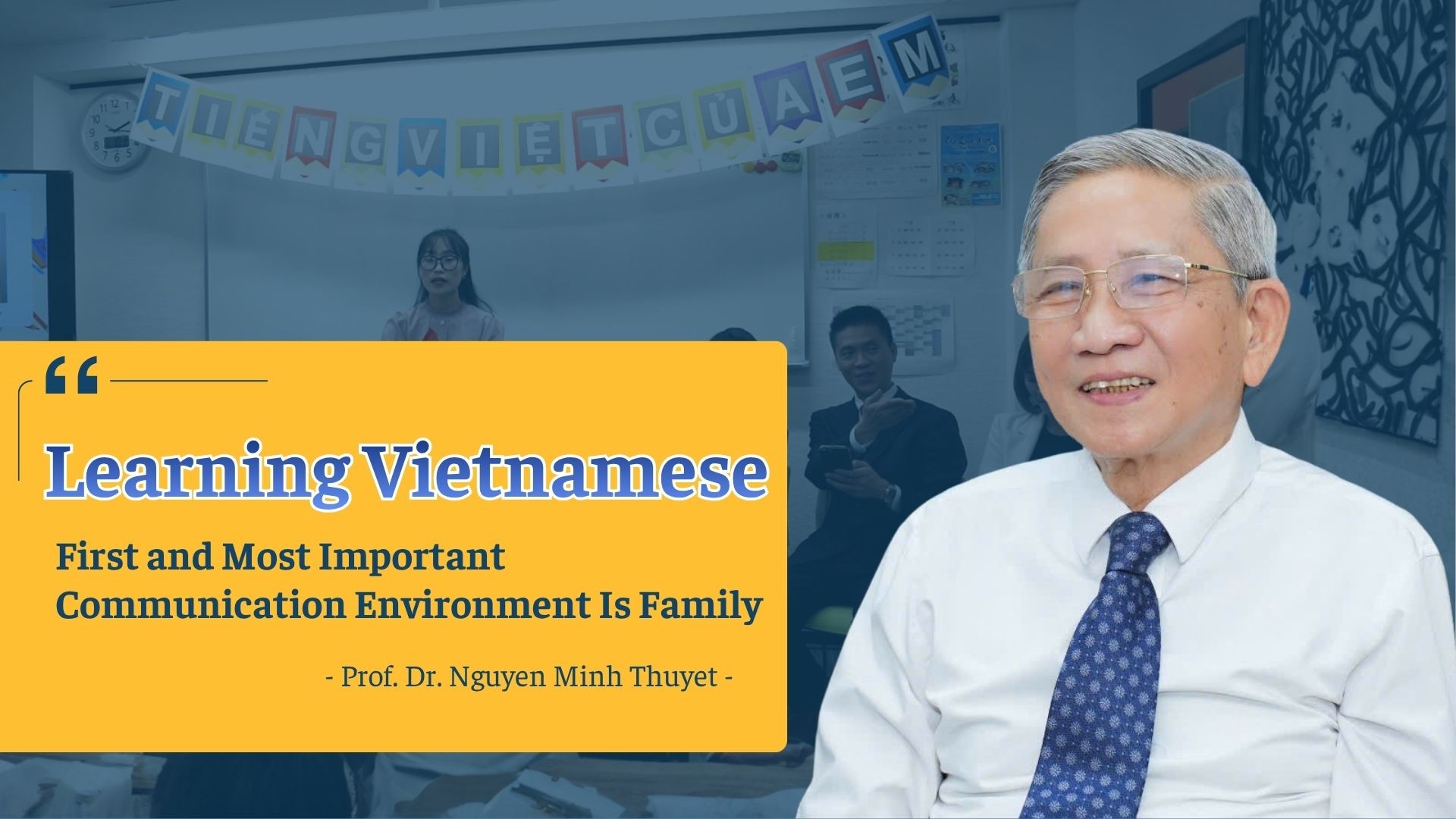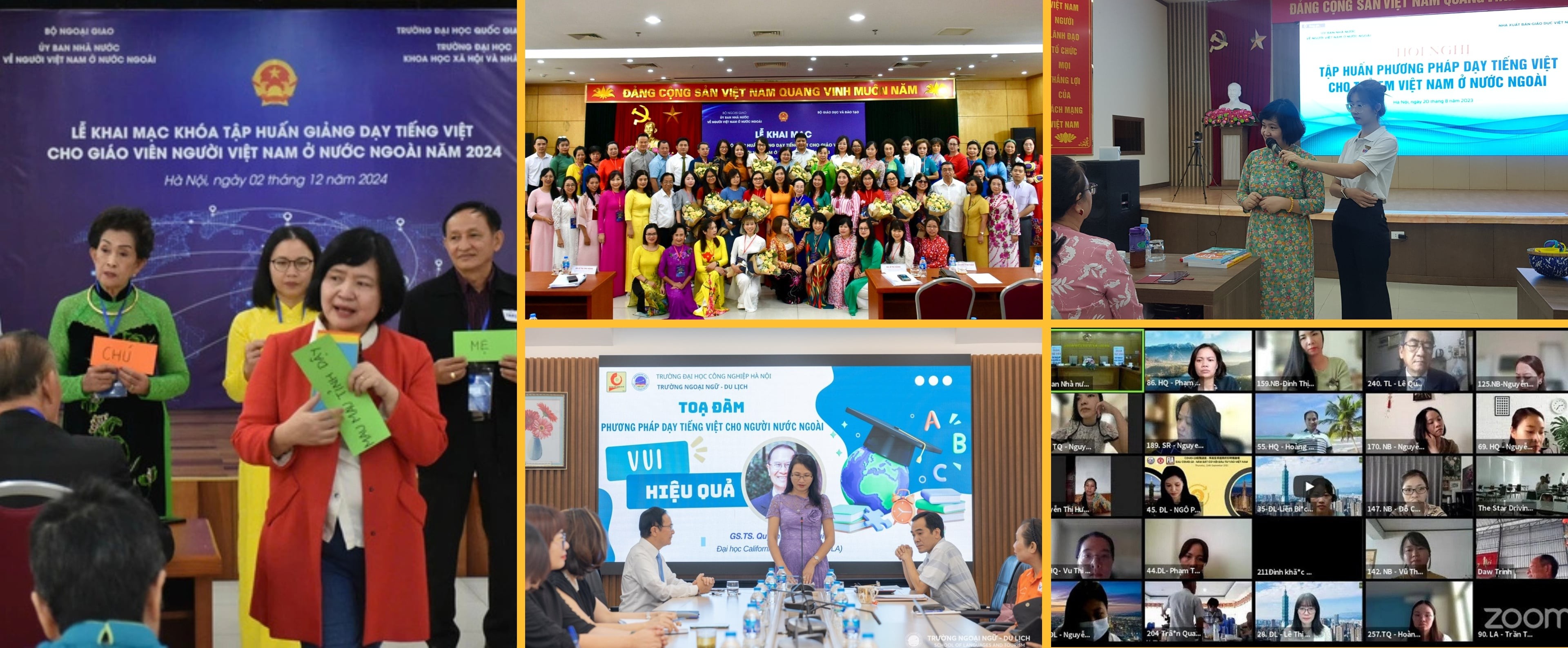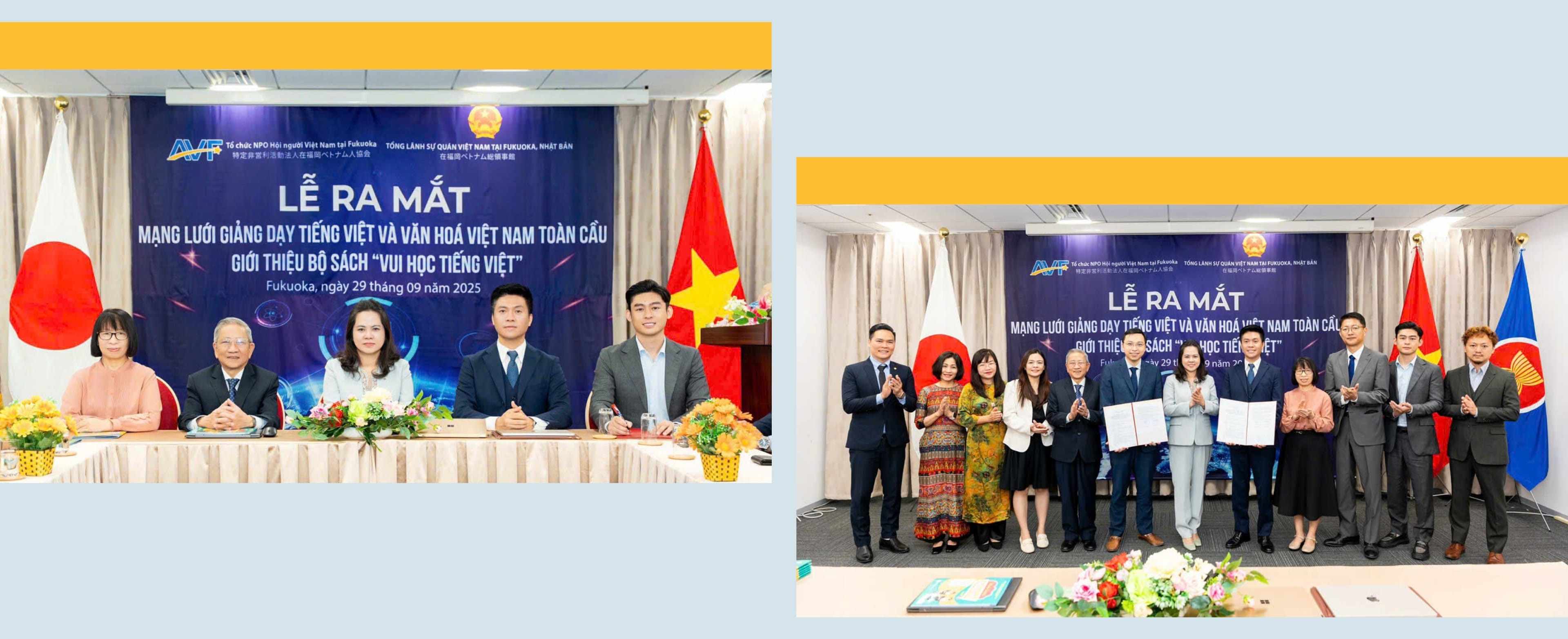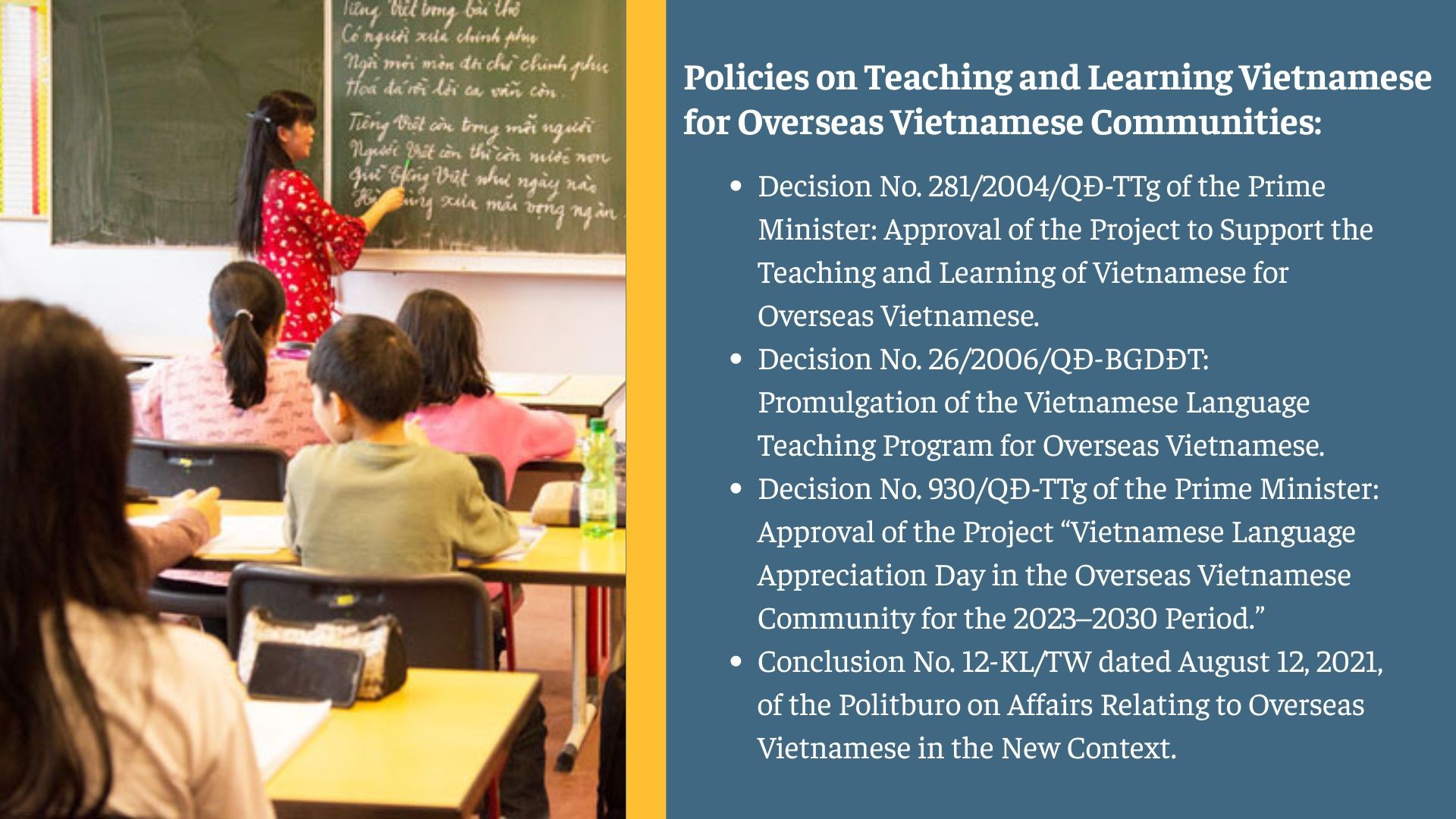 |
|
|
|
- In recent years, what measures has Vietnam implemented in teaching and learning Vietnamese for overseas Vietnamese communities? To meet the needs of overseas Vietnamese, on March 22, 2004, the Government issued Decision No. 281/2004/QĐ-TTg, approving the project “Supporting the Teaching and Learning of Vietnamese for Overseas Vietnamese.” The project consists of four main task groups, including the development of curricula, compilation of Vietnamese teaching materials, and training of teachers who teach Vietnamese to overseas Vietnamese learners. In implementing the Government’s Decision, the Ministry of Education and Training (MOET), as the lead agency of the project, has accomplished the following tasks: In 2006, MOET issued two Vietnamese language teaching programs for overseas Vietnamese: one for youths, teenagers, and children, and another for adults. In 2018, these two programs were merged and revised into a unified program for teaching Vietnamese to overseas Vietnamese. |
 |
| The two textbook series “Tieng Viet Vui” (Fun Vietnamese) and “Que Viet” (Vietnamese Homeland) are designed for teaching Vietnamese to overseas Vietnamese learners. |
|
Based on the two aforementioned programs, the Ministry of Education and Training (MOET) compiled and published two sets of Vietnamese language textbooks for overseas Vietnamese: the “Tiếng Việt Vui” (Fun Vietnamese) series for youths and teenagers, and the “Quê Việt” (Vietnamese Homeland) series for adults. These textbooks were published and distributed free of charge, available in both print and digital formats on online platforms. Drawing from these textbooks, the Voice of Vietnam (VOV) and Vietnam Television (VTV) also developed and broadcast Vietnamese language lessons on radio and television. Subsequently, in 2017, under the agreement between the Government of Vietnam and the Government of the Lao People’s Democratic Republic, MOET directed the Vietnam Institute of Educational Sciences to compile and publish a set of Vietnamese textbooks for students in Laos, including two initial volumes designed for children with no prior knowledge of Vietnamese. The Ministry has also cooperated with the State Committee for Overseas Vietnamese Affairs (SCOV) and Vietnamese embassies abroad to organize numerous training courses, both in Vietnam and overseas, for teachers of Vietnamese within the overseas Vietnamese communities. |
 |
|
- How do you assess the effectiveness of Vietnamese language teaching and learning for children of overseas Vietnamese at present, Professor? What are the reasons behind it? According to the State Committee for Overseas Vietnamese Affairs (SCOV), there are currently more than six million Vietnamese people living in over 130 countries and territories, with 80% residing in developed nations. Living far from their homeland in unfamiliar environments, overseas Vietnamese must adapt to the language, culture, and economy of their host countries in order to integrate and develop. Yet, they always look toward their roots, preserving the noble values of Vietnamese culture while aspiring to pass on their love for the homeland and Vietnamese culture, including the Vietnamese language, to their children. However, the teaching and learning of Vietnamese for children of overseas Vietnamese have not achieved high effectiveness overall, due to several main challenges: First, there is a lack of suitable teaching materials. Overseas Vietnamese communities in most countries often use Vietnamese language textbooks brought from Vietnam as instructional materials. However, these textbooks are designed for students who already speak Vietnamese fluently before entering school; at the primary level, they focus on teaching reading and writing, and further developing listening and speaking skills to higher levels. Meanwhile, most children of overseas Vietnamese do not yet speak or speak Vietnamese only haltingly; their vocabulary and grammar knowledge are limited or nonexistent, making them unsuitable for textbooks intended for students in Vietnam. At the same time, they, especially young children, cannot use textbooks for foreign learners of Vietnamese, since those are designed for adult learners who already have knowledge of their mother tongue and are generally familiar with the Latin alphabet. |
 |
|
Prof. Dr. Nguyen Minh Thuyet (front row, fifth from the right) attends the international seminar on the importance of teaching and preserving the Vietnamese language and culture within overseas Vietnamese communities. |
|
Second, there is a shortage of qualified teachers with appropriate professional training. In most countries, teachers of Vietnamese are dedicated members of the community who hold various other occupations and have not received formal training in linguistics or pedagogy. Therefore, except for those with many years of teaching experience who have accumulated practical knowledge, the majority of teachers still face numerous challenges and have yet to achieve the desired teaching effectiveness. Third, there is a lack of Vietnamese-speaking environments. A communication environment includes the material and spiritual conditions that stimulate and support human interaction. Like their predecessors, Vietnamese children abroad must first master the local language in order to study and develop. Their daily exposure to and use of the local language both necessitate and facilitate proficiency in it. However, when it comes to learning Vietnamese, apart from communication within the family, opportunities for social interaction in Vietnamese, as well as access to supporting resources such as books, newspapers, radio and television programs, and films in Vietnamese, are extremely limited. This poses a major obstacle to the application of learned knowledge and the development of Vietnamese language skills. - In your opinion, what new measures are needed to improve the effectiveness of Vietnamese language teaching for children of overseas Vietnamese, Professor? To continue assisting overseas Vietnamese communities in enhancing the effectiveness of Vietnamese language teaching for their children, we propose several new measures as follows: First, on textbook development. Fortunately, in recent years, several new sets of Vietnamese language textbooks for overseas Vietnamese children have been published. Notably, the newly established Global Network for Teaching Vietnamese Language and Culture has promptly collaborated with the Ho Chi Minh City University of Education Publishing House to compile the textbook series “Vui hoc tieng Viet” (Joyful Vietnamese Learning). The first volume, designed for children who have no prior knowledge of Vietnamese or the Latin alphabet, was released just over a month ago. |
 |
| Launch ceremony of the Global Network for Teaching Vietnamese Language and Culture. |
|
The Network will conduct online training sessions for teachers using this textbook on the mornings of November 1, 8, and 15, 2025, from 10:00 to 12:00 (Vietnam time). The sessions will be recorded and uploaded online to serve teachers in countries and territories unable to attend live due to time zone differences. Second, on teacher training. Although, in recent years, the Project on Supporting the Teaching and Learning of Vietnamese for Overseas Vietnamese, along with MOET and the State Committee for Overseas Vietnamese Affairs (SCOV), has organized numerous in-person training courses for teachers, a large number of teachers have yet to participate. Given the limited state budget, it is difficult to sustain frequent in-person training. Even the world’s most developed countries cannot afford to dispatch experts to hundreds of nations or to invite teachers from every country to attend in-person training sessions. Therefore, in the coming period, the Ministry of Education and Training should take the lead, in coordination with SCOV, Vietnam Television (VTV), and the Voice of Vietnam (VOV), in organizing online teacher training programs. These should be conducted on a regular basis, with one designated unit under MOET assuming responsibility for implementation. |
|
Third, renewing teaching methods. Over the years, there have been many teaching methods, but they can generally be categorized into two main approaches: the structural-oriented approach (focusing on grammar instruction) and the communication-oriented approach (teaching through communicative activities in real-life contexts to meet communication needs). When applying the communication-oriented approach to teaching Vietnamese to overseas Vietnamese children and youth, teachers should keep in mind the following points: Lessons should be conducted in Vietnamese. For beginner classes, since students may not yet understand classroom instructions (such as speaking, listening, or repetition tasks), teachers can repeat the instructions while demonstrating the actions so that students can grasp what to do; Teach oral language first before introducing the written form; Teach concrete words and sentences illustrated by images before moving on to abstract meanings; Place students in specific communicative situations to help them absorb and practice linguistic rules. For difficult tasks, the teacher should demonstrate first or invite one or two students to model the activity before the whole class follows. Fourth, creating a favorable communication environment. The first and most important communication environment is the family. Therefore, parents should sing Vietnamese lullabies and talk to their children in Vietnamese to stimulate auditory perception and help them become familiar with the sounds of the language. They should also use gestures and facial expressions to connect words with actions, helping children initially understand the meanings of words and sentences. |
 |
| It is essential to create a favorable environment for Vietnamese children abroad to experience Vietnamese culture and communicate in the Vietnamese language. |
|
During the pre-operational stage (from 2 to 7 years old), children begin to use language to express their thoughts, though their reasoning abilities are still limited. Parents should support their children by teaching vocabulary and sentences through pictures, telling stories, and engaging in role-play activities to help them expand their vocabulary and understand how to use language in specific contexts. Toward the end of this stage, as children start attending school, parents should ask about what their children learned each day, discuss classroom topics, and coordinate with teachers to enhance learning outcomes. Children should also be encouraged to watch Vietnamese cartoons, music videos, and television programs designed for young audiences. If even the family fails to create a favorable environment for children to learn Vietnamese from an early age, they will face significant challenges similar to those encountered by foreign learners of Vietnamese, such as pronouncing tones accurately and using proper terms of address according to social roles. The second important communication environment is the classroom. Classrooms should be decorated with Vietnamese images, as well as photos and names of students written in Vietnamese, to create a warm, familiar Vietnamese atmosphere that encourages learning. Teachers should strive to communicate with students in Vietnamese as much as possible. We also recommend that Vietnam Television (VTV) produce and broadcast more Vietnamese learning videos, similar to English-language programs such as ABC Song, Baby Shark, and Baby Bus. Furthermore, publishing houses, particularly the Vietnam Education Publishing House and Kim Đong Publishing House, should develop and publish more illustrated Vietnamese learning books and simple, engaging reading materials for Vietnamese children living abroad to support their language learning. - Thank you very much! |
 |
|
Written by: Pham Ly Designed by: Mai Anh Published on: November 01, 2025 |